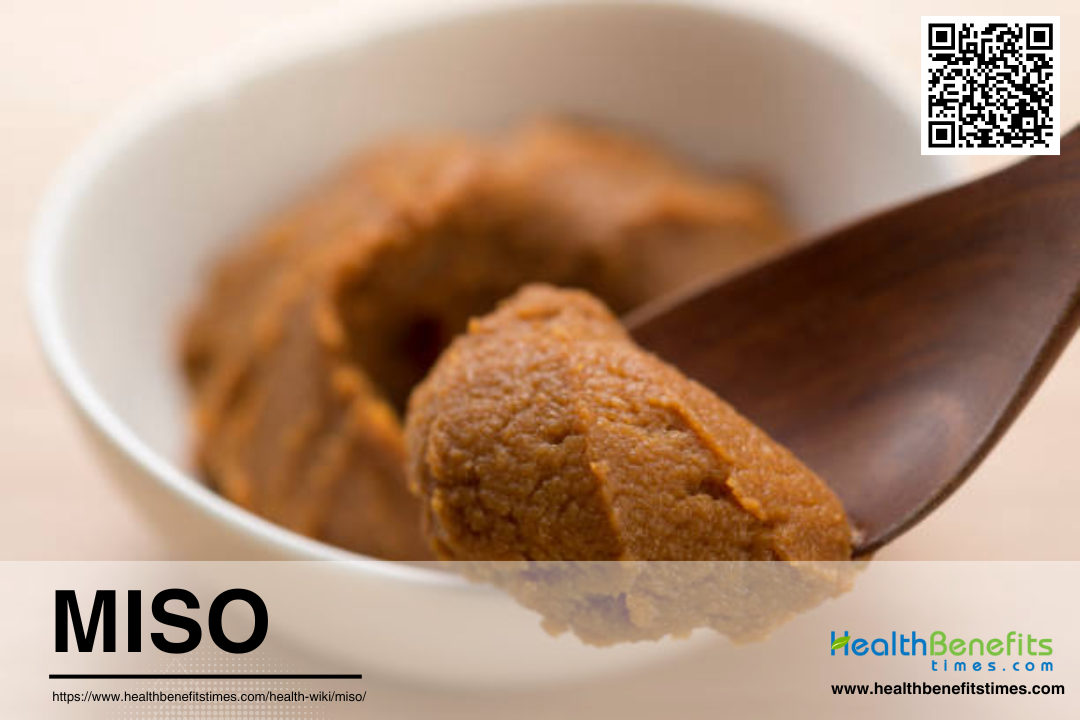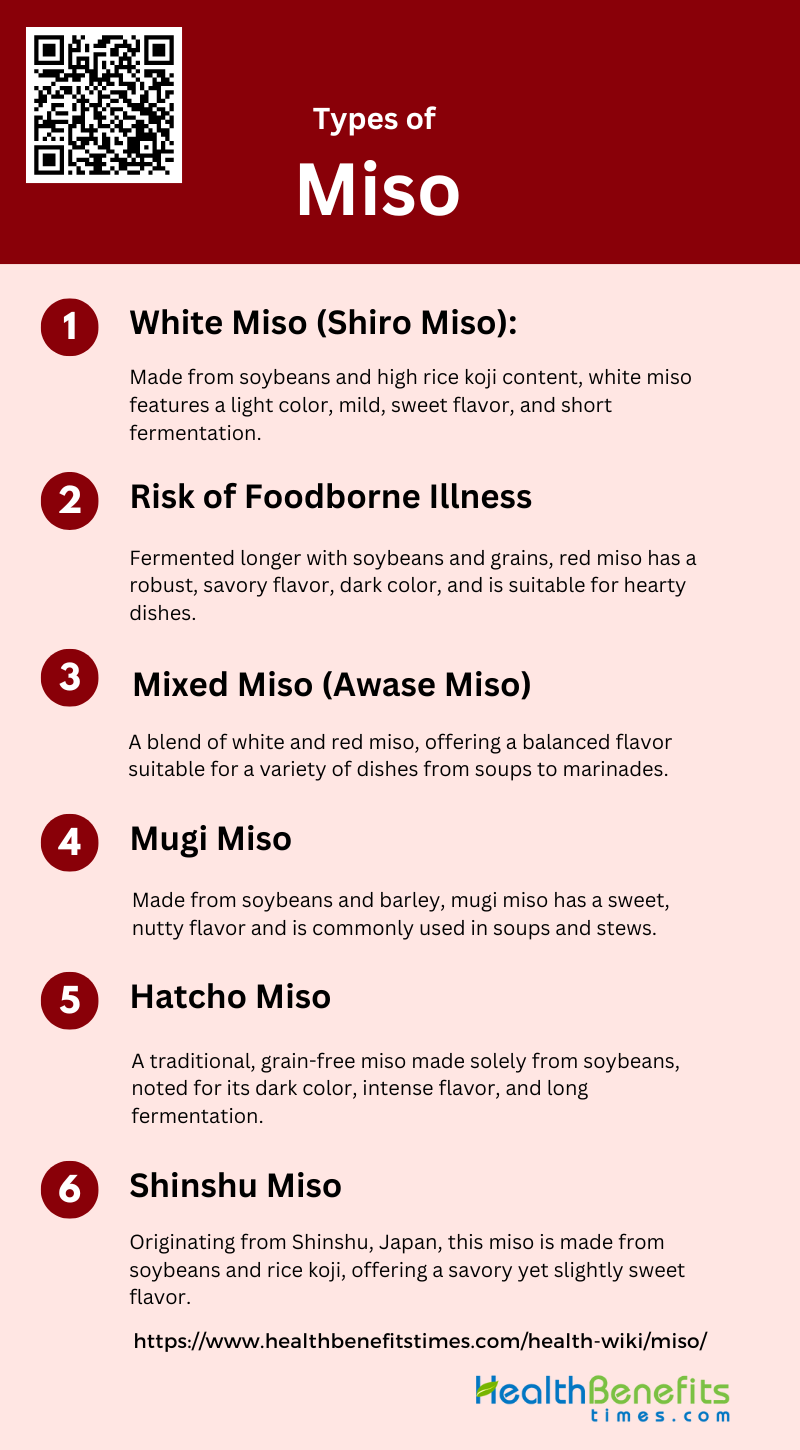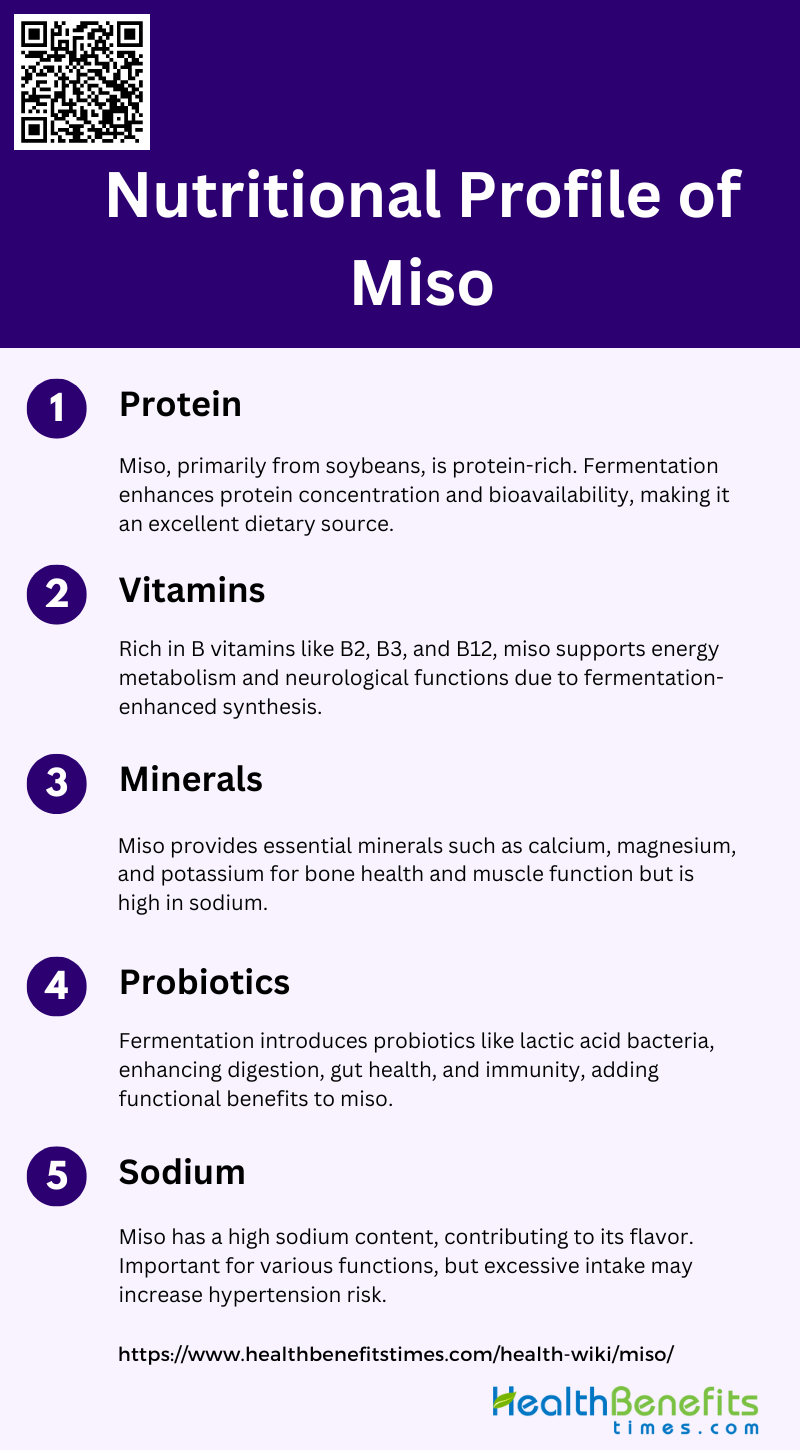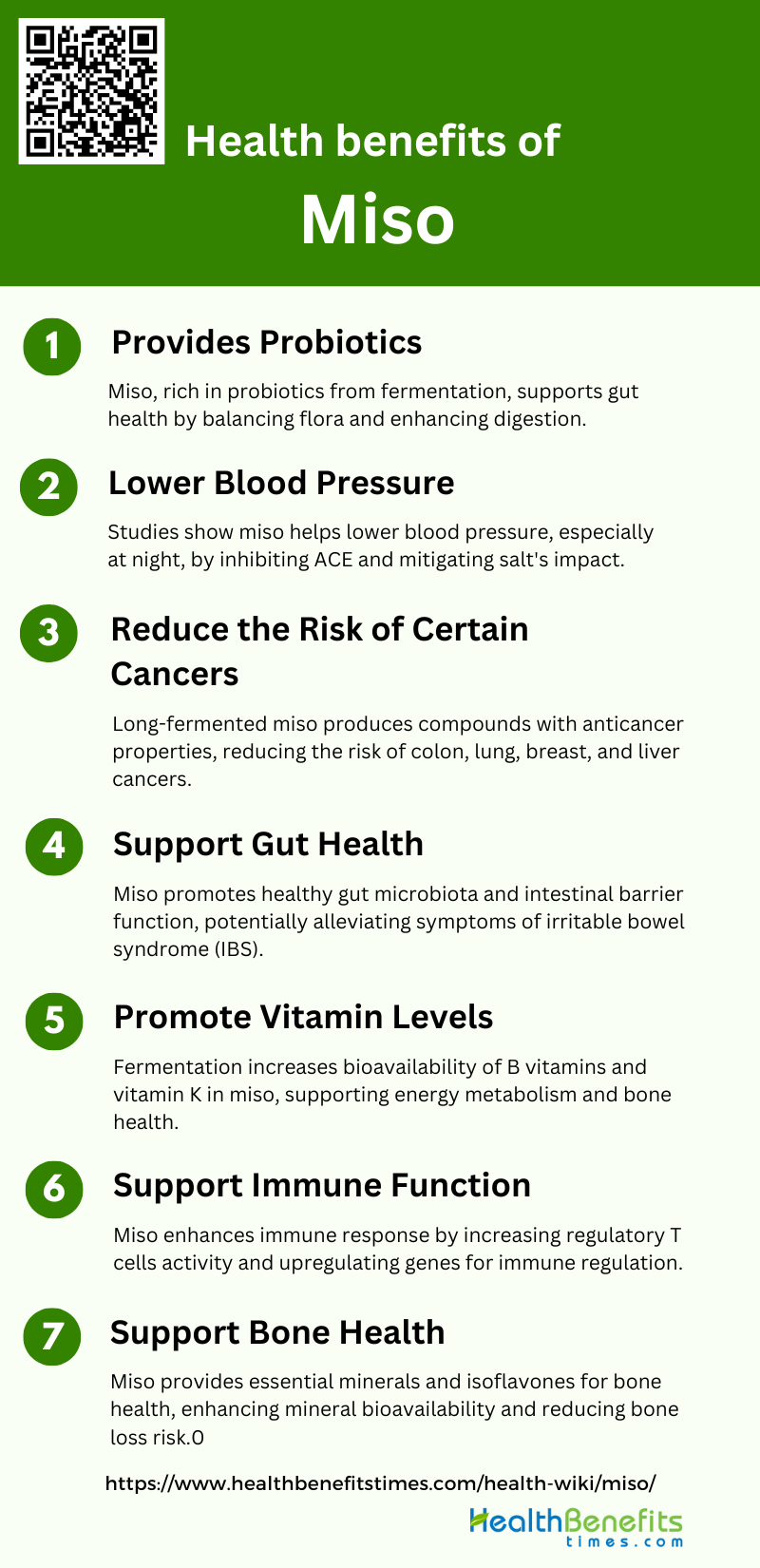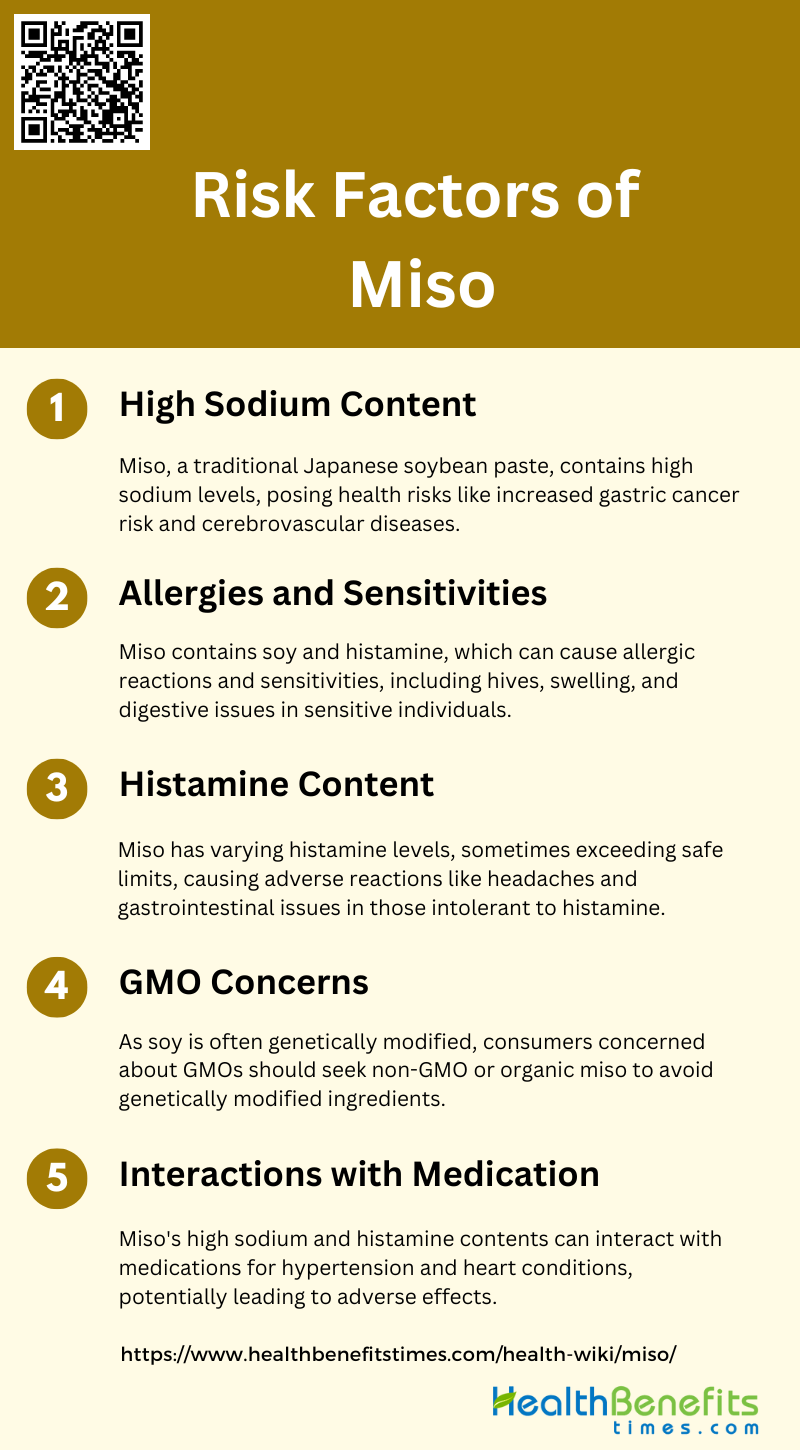Miso is a traditional Japanese seasoning paste made by fermenting soybeans with the help of koji mold. This fermentation process not only imparts a unique savory flavor and aroma to miso but also enhances its nutritional profile. Miso is rich in beneficial enzymes and bioactive compounds, which contribute to its health benefits, such as reducing the risk of death and modulating oxidative stress and inflammation. The production of miso involves a two-stage fermentation process, where the initial stage uses molds like Aspergillus oryzae to create koji, and the subsequent stage involves bacteria and yeast to complete the fermentation. Different types of miso, including soy miso and fish miso, have distinct flavor profiles influenced by their volatile compounds. Additionally, miso consumption has been linked to various health benefits, including the suppression of visceral fat accumulation and the enhancement of immune responses.
Types of Miso
There are several types of miso, each with its own unique flavor, color, and use. Here are some common types:
1. White Miso (Shiro Miso)
White miso, also known as shiro miso, is a type of miso that is characterized by its light color and mild flavor. It is typically made from soybeans and a high proportion of rice koji, which contributes to its sweetness and lower salt content compared to other types of miso. The fermentation period for white miso is relatively short, usually ranging from a few weeks to a few months. This short fermentation time results in a lighter color and a sweeter taste, making it a popular choice for soups, dressings, and marinades. White miso is often used in Japanese cuisine to add a subtle umami flavor without overpowering the dish.
2. Red Miso (Aka Miso)
Red miso, or aka miso, is known for its deep, rich flavor and darker color, which ranges from reddish-brown to dark brown. This type of miso is made from soybeans and barley or other grains, and it undergoes a longer fermentation process, often lasting from six months to several years. The extended fermentation time allows for the development of complex flavors and a higher salt content. Red miso is robust and savory, making it suitable for heartier dishes such as stews, braises, and marinades. Its strong umami profile is attributed to the breakdown of proteins and the formation of amino acids during fermentation.
3. Mixed Miso (Awase Miso)
Mixed miso, or awase miso, is a blend of different types of miso, typically combining white and red miso to achieve a balanced flavor profile. This combination allows for the mild sweetness of white miso to complement the robust, savory notes of red miso. The ratio of white to red miso can vary, allowing for customization based on the desired taste and application. Awase miso is versatile and can be used in a wide range of dishes, from soups and sauces to marinades and dressings. It offers a harmonious blend of flavors, making it a popular choice in both traditional and modern Japanese cuisine.
4. Mugi Miso
Mugi miso is a type of miso made primarily from soybeans and barley (mugi). It is known for its slightly sweet and nutty flavor, which is a result of the barley used in its production. The fermentation process for mugi miso can vary, but it typically lasts from a few months to a year, allowing for the development of a rich, complex taste. Mugi miso is often used in soups, stews, and marinades, and it is particularly popular in certain regions of Japan. Its unique flavor profile makes it a versatile ingredient that can enhance a variety of dishes.
5. Hatcho Miso
Hatcho miso is a traditional Japanese miso made exclusively from soybeans, without the addition of grains like rice or barley. It is known for its dark color and intense, robust flavor, which is a result of a long fermentation process that can last up to three years. Hatcho miso has high protein content and a rich umami taste, making it a popular choice for hearty dishes such as soups, stews, and sauces. Its strong flavor can also be used to add depth to marinades and glazes. Hatcho miso is often considered a premium miso due to its traditional production methods and complex flavor profile.
6. Shinshu Miso
Shinshu miso is a type of miso that originates from the Shinshu region in Japan. It is typically made from soybeans and rice koji, and it has a medium to dark color with a balanced flavor profile that is both savory and slightly sweet. The fermentation period for Shinshu miso can range from a few months to over a year, allowing for the development of a rich, umami taste. Shinshu miso is versatile and can be used in a variety of dishes, including soups, sauces, and marinades. Its balanced flavor makes it a popular choice for both traditional and contemporary Japanese cuisine.
How is miso made at home?
Making miso at home is a rewarding process that involves fermenting soybeans with salt and koji (a type of fungus). Here’s a basic guide to making miso:
1. Soak the Soybeans: Rinse the soybeans and soak them in plenty of water for at least 12 hours or overnight.
2. Cook the Soybeans: Drain the soaked soybeans and place them in a large pot. Cover with fresh water and bring to a boil. Reduce the heat and simmer for 3-4 hours, or until the soybeans are very soft. You should be able to easily mash them between your fingers.
3. Mash the Soybeans: Drain the cooked soybeans, reserving some of the cooking liquid. Mash the soybeans using a food processor, potato masher, or by hand. You can add some of the reserved cooking liquid if needed to achieve a smooth, paste-like consistency.
4. Mix with Koji and Salt: In a large bowl, combine the mashed soybeans with the koji and salt. Mix thoroughly to ensure even distribution.
5. Pack into Fermentation Container: Transfer the mixture into a clean fermentation container. Press down firmly to remove any air pockets. Smooth the surface and sprinkle a thin layer of salt on top to prevent mold growth.
6. Weight and Cover: Place a weight on top of the miso to keep it pressed down. Cover the container with cheesecloth or a clean cloth to allow air circulation while keeping out dust and insects.
7. Ferment: Store the container in a cool, dark place. The fermentation process can take anywhere from a few months to a couple of years, depending on the type of miso you want to make. Check occasionally to ensure no mold is growing on the surface. If mold appears, scrape it off and add a bit more salt.
8. Taste and Use: After the desired fermentation period, your miso is ready to use. Transfer it to smaller containers for easier use and storage. Keep it refrigerated to slow down further fermentation.
Nutritional Profile of Miso
It is rich in essential vitamins, minerals, and beneficial bacteria that support overall well-being. Here are some key nutrients found in miso:
1. Protein
The fermentation process involving Aspergillus oryzae and other microbes enhances the protein content and bioavailability. Studies have shown that miso can significantly increase dissolved protein concentration, making it a valuable protein source in the diet.
2. Vitamins
Miso contains various vitamins, including B vitamins such as B2 (riboflavin), B3 (niacin), and B12, which are essential for energy metabolism and neurological function. The fermentation process helps in the synthesis and preservation of these vitamins, contributing to the overall nutritional value of miso.
3. Minerals
Miso is rich in essential minerals like calcium, magnesium, and potassium, which are crucial for bone health, muscle function, and maintaining electrolyte balance. However, it also contains high levels of sodium, which should be consumed in moderation, especially by individuals with hypertension.
4. Probiotics
The fermentation process of miso involves beneficial microbes such as lactic acid bacteria and yeast, which contribute to its probiotic properties. These probiotics can improve gut health, enhance digestion, and boost the immune system, making miso a functional food with significant health benefits.
5. Sodium
While sodium is essential for various bodily functions, excessive intake can lead to health issues such as hypertension. Therefore, it is important to consume miso in moderation, especially for individuals with salt-sensitive conditions.
Health benefits of Miso
Its rich nutritional profile supports various aspects of well-being, from digestive health to immune function. Here are some key health benefits of miso:
1. Provides Probiotics
Miso, a traditional Japanese fermented soybean paste, is rich in probiotics, which are beneficial bacteria that support gut health. The fermentation process involves beneficial microbes, such as lactic acid bacteria, which contribute to the probiotic content of miso. These probiotics help maintain a healthy balance of gut flora, which is essential for digestion and overall health. Studies have shown that the microbial community in miso enhances its nutritional properties and supports gut health by promoting the growth of beneficial bacteria and inhibiting harmful pathogens.
2. Lower Blood Pressure
Research indicates that miso contains compounds that inhibit angiotensin-converting enzyme (ACE), which plays a role in blood pressure regulation. A study involving subjects with high-normal blood pressure or stage I hypertension found that long-term intake of miso significantly decreased nighttime blood pressure without affecting pulse rate. Additionally, miso’s unique properties may mitigate the effects of dietary salt on blood pressure, making it a beneficial food for managing hypertension.
3. Reduce the Risk of Certain Cancers
The fermentation process of miso produces bioactive compounds that exhibit anticancer effects. For instance, miso fermented for longer periods has been found to inhibit the development of colon, lung, breast, and liver tumors in animal models. These effects are attributed to the presence of isoflavones and other bioactive compounds that modulate cancer-related pathways and enhance the body’s defense mechanisms against cancer.
4. Support Gut Health
Miso supports gut health by promoting a healthy gut microbiota and enhancing intestinal barrier function. Probiotic yeast isolated from miso has been shown to ameliorate stress-induced visceral hypersensitivity and improve symptoms of irritable bowel syndrome (IBS) in animal models. The administration of this probiotic yeast improved tight junction integrity in the gut, which is crucial for maintaining a healthy intestinal barrier. These findings suggest that miso can be a valuable source of probiotics that support gut health and prevent gastrointestinal disorders.
5. Promote Vitamin Levels
The fermentation process enhances the bioavailability of these vitamins, making them more accessible for absorption by the body. Miso contains significant amounts of B vitamins, which are essential for energy metabolism, and vitamin K, which is important for blood clotting and bone health. Regular consumption of miso can contribute to meeting daily vitamin requirements and support overall nutritional status.
6. Support Immune Function
Miso has immunomodulatory properties that support immune function. Studies have shown that miso consumption increases the activity of immune cells, such as regulatory T cells and germinal center B cells, which play a crucial role in immune response and tolerance. Miso also upregulates the expression of genes involved in immune regulation, such as interleukin (IL)-10 and IL-22. These effects enhance the body’s ability to respond to infections and prevent autoimmune diseases, making miso a valuable food for supporting immune health.
7. Support Bone Health
The fermentation process also enhances the bioavailability of these minerals, making them more readily absorbed by the body. Additionally, miso contains isoflavones, which have been shown to have bone-protective effects by modulating bone metabolism and reducing bone loss. Regular consumption of miso can contribute to better bone health and reduce the risk of osteoporosis.
Culinary Uses of Miso
Its unique umami taste makes it a popular choice in both traditional and modern recipes. Here are some common culinary uses of miso:
1. Soup
Miso soup is a staple in Japanese cuisine, often enjoyed for its rich umami flavor and health benefits. The primary ingredient, miso paste, is made by fermenting soybeans with koji mold, which enhances its nutritional profile and introduces beneficial enzymes and microbes. Miso soup typically includes ingredients like tofu, seaweed, and green onions, making it a nutritious and balanced dish. The fermentation process not only improves the digestibility of soybeans but also increases the bioavailability of nutrients, contributing to its health-promoting properties.
2. Seasoning in Cooking
It is often added to broths, sauces, and marinades to enhance the overall taste of the dish. The fermentation process of miso produces a variety of volatile compounds that contribute to its unique aroma and flavor, making it a versatile ingredient in both traditional and modern cooking. Additionally, miso’s high protein and nutrient content make it a valuable addition to any meal.
3. Marinades and Dressings
Miso is an excellent base for marinades and dressings, providing a depth of flavor that enhances the taste of meats, vegetables, and salads. The enzymes in miso help to tenderize meat, making it more succulent and flavorful. Moreover, the bioactive compounds in miso, such as isoflavones and phenolic acids, offer additional health benefits, including anti-inflammatory and antioxidant properties. Using miso in marinades not only improves the taste but also adds nutritional value to the dish.
4. Salad Dressing
These dressings often combine miso with ingredients like vinegar, oil, and sweeteners to create a balanced and flavorful topping for salads. The fermentation process of miso enhances its nutritional profile, making it a healthy addition to salads. The bioactive compounds in miso, such as isoflavones, contribute to its antioxidant and anti-inflammatory properties, making it a functional food choice.
5. Sandwich Fillings
Miso can be used as a unique and flavorful ingredient in sandwich fillings. Its umami-rich taste pairs well with various ingredients, such as vegetables, meats, and cheeses, adding depth and complexity to the sandwich. The fermentation process of miso not only enhances its flavor but also increases its nutritional value, providing essential amino acids, vitamins, and minerals. Incorporating miso into sandwich fillings can elevate the taste and nutritional profile of a simple meal.
6. Stir-Fries
The enzymes in miso help to break down proteins, making the ingredients more tender and flavorful. Additionally, the bioactive compounds in miso, such as isoflavones and phenolic acids, offer health benefits, including anti-inflammatory and antioxidant properties. Using miso in stir-fries not only enhances the taste but also boosts the nutritional value of the dish.
7. Stews, Chilies
Its umami-rich profile pairs well with hearty ingredients like beans, meats, and vegetables. The fermentation process of miso increases its nutritional value, making it a healthy addition to stews and chilies. The bioactive compounds in miso, such as isoflavones and phenolic acids, contribute to its antioxidant and anti-inflammatory properties, making it a functional food choice.
8. Pestos
The fermentation process of miso enhances its nutritional profile, providing essential amino acids, vitamins, and minerals. Additionally, the bioactive compounds in miso, such as isoflavones and phenolic acids, offer health benefits, including anti-inflammatory and antioxidant properties. Incorporating miso into pestos can elevate the taste and nutritional value of this classic sauce.
9. Vegan Cheese
Miso is a popular ingredient in vegan cheese recipes, providing a rich umami flavor that mimics the taste of traditional cheese. The fermentation process of miso enhances its nutritional profile, making it a healthy addition to vegan cheese. The bioactive compounds in miso, such as isoflavones and phenolic acids, contribute to its antioxidant and anti-inflammatory properties, making it a functional food choice. Using miso in vegan cheese not only improves the taste but also adds nutritional value to the product.
Risk Factors of Miso
While miso is a popular and nutritious fermented food, it is important to be aware of certain risk factors associated with its consumption. These risks can vary depending on individual health conditions and the type of miso consumed. Below are some key risk factors to consider:
1. High Sodium Content
Studies have shown that high sodium intake is associate.
d with an increased risk of gastric cancer. For instance, a study found that individuals who consumed three or more bowls of miso soup daily had a 60% higher risk of developing gastric cancer compared to those who consumed less. Additionally, regional variations in sodium chloride content in miso have been linked to higher death rates from cerebrovascular diseases. Despite some protective effects against hypertension, the high sodium content remains a concern.
2. Allergies and Sensitivities
Individuals with soy allergies may experience adverse reactions such as hives, swelling, and digestive issues upon consuming miso. Furthermore, miso can contain histamine and other biogenic amines, which can trigger allergic reactions or sensitivities in some people. A study found that certain miso products had histamine levels exceeding the allowable limit, which could pose risks for those sensitive to histamines. Therefore, individuals with soy allergies or histamine sensitivities should exercise caution when consuming miso.
3. Histamine Content
Histamine is a biogenic amine that can cause adverse reactions such as headaches, flushing, and gastrointestinal issues. Miso products have been found to contain varying levels of histamine, with some samples exceeding the recommended limits. A study identified several histamine-producing bacterial strains in miso, which can lead to elevated histamine levels. This is particularly concerning for individuals with histamine intolerance, as consuming miso could exacerbate their symptoms. Therefore, monitoring and controlling histamine levels in miso products are essential for consumer safety.
4. GMO Concerns
Genetically modified organisms (GMOs) are a topic of concern for many consumers, particularly in relation to soy products like miso. While the provided data does not directly address GMO content in miso, it is important to note that soybeans are one of the most commonly genetically modified crops. Consumers who are concerned about GMOs should look for miso products labeled as non-GMO or organic to ensure they are not consuming genetically modified ingredients. This is crucial for those who prefer natural and unmodified food sources.
5. Interactions with Medication
High sodium intake can counteract the effects of antihypertensive drugs, making it more difficult to control blood pressure. Additionally, the histamine content in miso can interact with medications that affect histamine pathways, potentially leading to adverse effects. Therefore, individuals on medication for hypertension or other cardiovascular conditions should consult their healthcare provider before incorporating miso into their diet.


